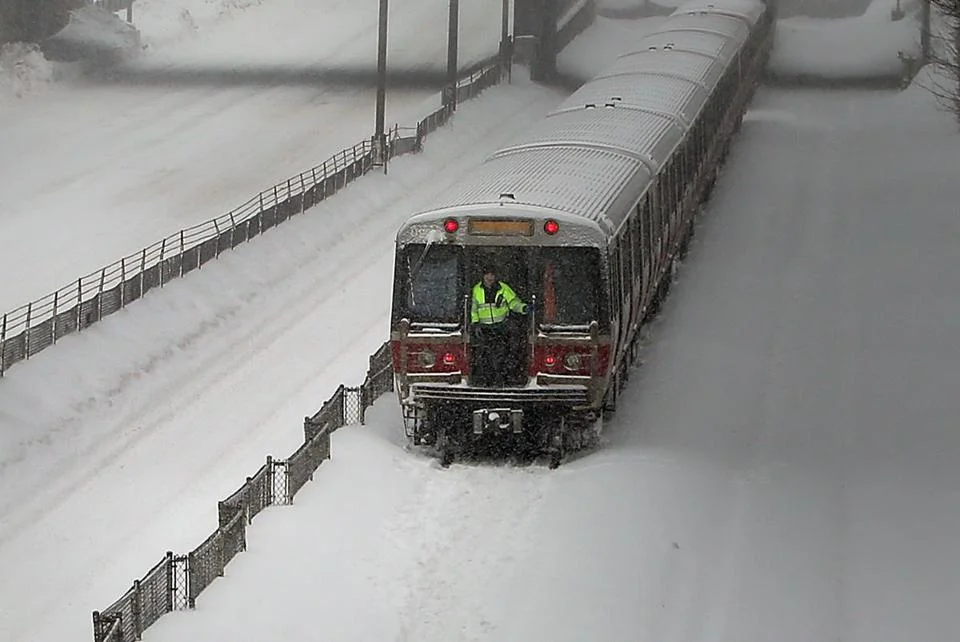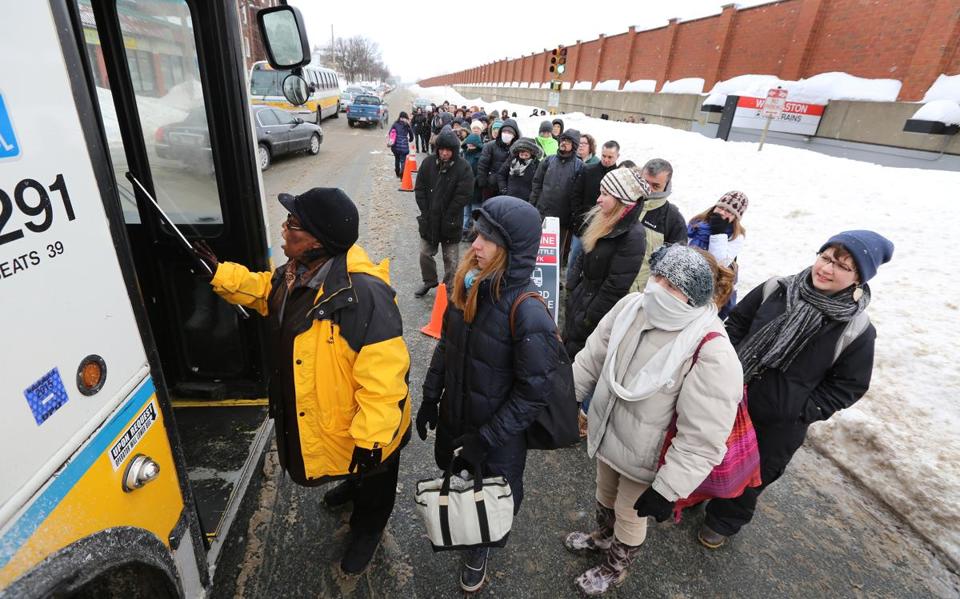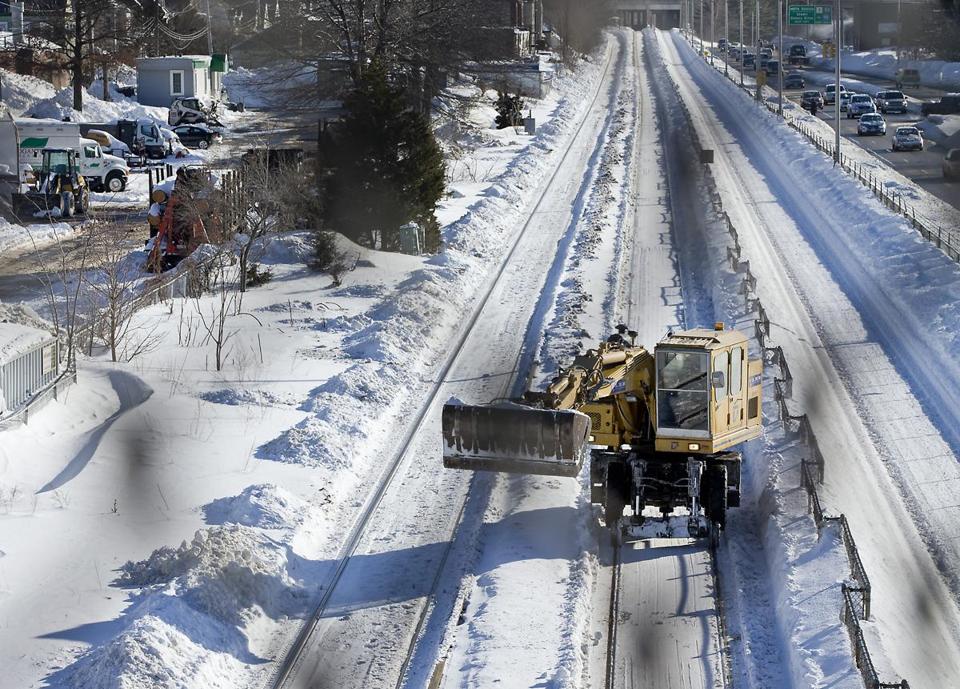
An Emergency Transportation Plan to Fix Boston's Transit Crisis
Yesterday we learned that due to decades of neglect the MBTA will need at least 30 days to restore service to the normal level of delays, signal problems and disabled trains we're used to. While there is plenty of blame to go around, right now we must focus on the current emergency.
Yesterday we learned that due to decades of neglect the MBTA will need at least 30 days to restore service to the normal level of delays, signal problems and disabled trains we're used to. While there is plenty of blame to go around, right now we must focus on the current emergency.




We must act quickly to implement a temporary transit network that would people to resume their lives before the state's economy collapses and half the city's population is out of work. Mayor Walsh and MBTA General Manager Beverly Scott should seek help from cities and transit agencies who have experience with natural disasters. With bold political leadership and around 1,000 buses from across the northeast we can put an emergency transportation plan into action.
For guidance we should look to MTA New York City Transit, which in 2012 implemented emergency "bus bridges" connecting Brooklyn and Manhattan two days after Hurricane Sandy knocked out all subway service in the city's core (photos). The city used simple cones to create dedicated bus lanes along the shuttle route and police officers to enforce the lanes and keep over 200 buses moving on each route. MTA also ran a long-term shuttle route to replace the A line in Queens and a year earlier replaced suspended commuter rail service after Hurricane Irene.
Here and now, a network of emergency shuttle bus routes must be created based roughly on known travel patterns. Bus routes would not exactly mimic subway corridors but they would get you into the city's core where you can walk or use what's left of the T. Some routes would use dedicated bus lanes and receive priority over all other traffic, with police enforcement, while other corridors would be open only to buses. For all of the issues with bus service, the MBTA does a great job running shuttle bus links such as Harvard-Alewife and Lechmere-North Station when things are planned in advance.
Cars carrying fewer than 3 occupants would be prohibited from entering the city or using major highways inside Route 128. Slug lanes would allow those who must drive from suburban areas to pickup additional passengers before continuing on. Large parking lots along I-495 and Route 128 can be turned into park-and-ride lots with bus shuttles operating in dedicated bus lanes on all major highways.
Bikes must be part of the solution. It is certainly cold outside but desperate times call for desperate measures. Better to ride 3 miles in the cold than wait for a bus in the cold for the same 15 minutes, and every 50 bikes represents one more bus available elsewhere. Designating corridors like Washington St, Massachusetts Ave, Huntington St and Commonwealth Ave for buses and bicycles only would enable reasonably fast limited-stop bus service while giving people people a safe place to ride. Secure bicycle parking tents can be setup in several downtown locations and an emergency ordinance could require most office buildings to allow bikes inside until full subway service resumes.
Walking should be encouraged whenever possible in order to minimize stress on the transit system. Bostonians have not experienced a transit strike in recent decades but experience from other cities shows people will gladly walk a few miles if they can. Currently our sidewalks are a treacherous mix of snow and ice, so vehicle lanes can be converted to pedestrian lanes until sidewalks are clear, with some key roads open to buses and pedestrians only.
Some of these measures may sound extreme, but desperate times call for desperate measures, and I believe even the harshest critics of transit would be surprised by how well the city would function if they would just allow a demonstration.
At the very least, this plan would prevent the total collapse of the region and it is our chance to show definitively that a fast, frequent and comprehensive transit network is invaluable to the entire region. Eventually we'll wonder how we ever lived without one.
MBTA General Manager Search Process Now Underway
 Despite initially tepid response to the open position for MBTA General Manager (and MassDOT Rail and Transit Administrator), a number of applicants have stepped forward in the month since it was last reported on the matter.
Despite initially tepid response to the open position for MBTA General Manager (and MassDOT Rail and Transit Administrator), a number of applicants have stepped forward in the month since it was last reported on the matter.
From the Board of Directors, John Jenkins, Elizabeth Levin, and Secretary Richard Davey comprise the three person preliminary search committee who met this morning to begin screening the applicants who have thrown themselves into the pool thus far.
Their intent is to narrow down the pool of applicants to three to four candidates to present to the board with a group interview of selected candidates. So far, there are over 40 applicants with varying degrees of operational and leadership expertise, including candidates with experience from Toronto's TTC to San Francisco's MUNI. 13 of those were put to consideration this morning.
Aside from the desired qualities listed in the posting on the MBTA web site, the committee repeated its desire for candidates with good on-the-ground, operational expertise balanced with well-rounded experience across organisation operations and strong leadership experience.
Through all of this, will we end up with a GM who can lead the MBTA and continue with the internal organisational reform started by Rich Davey almost two years ago? Unlike in New York, where there has been enough political conflict to lead their last and most qualified CEO to resign, Governor Patrick strongly supports both MassDOT and the MBTA and we rarely see him bash either of them. Does it help that the Governor's office is not more than 850 metres away from both the Secretary's and General Manager's office, just across the Commons?
Suffice it to say, the upcoming MBTA GM will be managing the 6th most used public transport system in the US with the greatest debt of them all. S/he will need to work closely with the Governor, Secretary, and legislature in not only securing the funds necessary to operate the economic engine of the Commonwealth, but also show competence in affecting effective reform in the nation's most organisationally flat public transport operator. With little political friction to deal with (compared to that of the MBTA's closest neighbours in the US), the next GM will be able to focus on actually running the system and the search committee will be able to look for a candidate who has more public transport operations experience than New York's new MTA CEO, who is more known for his political and financial management savvy than his (nonexistent) transit experience.
The position remains open to applicants until the end of this year and the search committee will continue to filter candidates as they come in.
Transit Construction During the Great 'Recession'
 I'm currently killing some time before heading off to a discussion at the Museum of the City of New York on the challenges facing ongoing and planned transit construction projects in the New York City metro region during these trying economic times. Boston has it's own projects that have been stalled (or in an extended design and environmental review process) for quite some time until this most recent MassDOT/MBTA Board of Directors meeting: the Orange Line infill station at Assembly Square, the Green Line Extension to Route 16 (the current project only extending to College Avenue, one stop shy of the legal requirement for the project to reach Medford), the Blue Line extension to Charles-MGH, further Blue Line extensions beyond Wonderland, drafting and design of new Red and Orange Line cars.
I'm currently killing some time before heading off to a discussion at the Museum of the City of New York on the challenges facing ongoing and planned transit construction projects in the New York City metro region during these trying economic times. Boston has it's own projects that have been stalled (or in an extended design and environmental review process) for quite some time until this most recent MassDOT/MBTA Board of Directors meeting: the Orange Line infill station at Assembly Square, the Green Line Extension to Route 16 (the current project only extending to College Avenue, one stop shy of the legal requirement for the project to reach Medford), the Blue Line extension to Charles-MGH, further Blue Line extensions beyond Wonderland, drafting and design of new Red and Orange Line cars.
Thinking on that and a political comic from 1938 on the then titled 'recession' that I came across at the MCNY, infrastructure investment has always proven to be a means of driving economic recovery by putting people back to work and providing improved mobility for commerce during down economic times and after economic recovery.
The Obama administration is two years late in offering such a solution, instead having opted to deal first with the politically unpopular healthcare reform he initially promised during his campaign. Nevertheless, the Obama administration, the Federal DOT, and Transportation Secretary Ray LaHood have outlined a budget for a more 'balanced' transportation budget, improving the budget ratio between transit and roads from 20:80 to 24:76.
Even more unfortunately, the mass transit funding debate often gets overshadowed by the high speed rail funding debate, the latter of which is currently being played out on the national political stage with sweeping action and unfortunately dramatic rejections of funding. Within mass transit funding, there are significant issues between expanding service and improving network access within cities, the former enabling more suburban settlement farther from city centers and the latter strengthening networks within cities and making them more resilient to network failures (i.e. medical emergencies, police activity, and disabled trains).
Will we 'win the future'? Maybe. But we've already lost a lot of time and money propping up companies rather than the physical infrastructure that enables us to live, work, and play.
Categories
- Children (1)
- Diversions (1)
- Olympics (1)
- MAPC (2)
- Red–Blue Connector (2)
- Urban Design (3)
- Bus (4)
- Fares (4)
- Late Night Service (4)
- MBTA ROC (4)
- Silver Line (4)
- Snow (5)
- Blue Line (8)
- Emergency (8)
- Orange Line (8)
- Public Comment (8)
- Maintenance (9)
- Operations (9)
- Signage (9)
- Fare Collection (10)
- Labs (11)
- Safety (11)
- Planning (12)
- Communication (14)
- MBCR (14)
- MassDOT (14)
- Green Line (16)
- History & Culture (16)
- Red Line (18)
- MBTA Bus (21)
- Commuter Rail (24)
- Advocacy (26)
- Capital Construction (28)
- Politics (30)
- Podcast (35)
- News (38)
- Media (40)
- Funding (42)
- Statements (50)
- MBTA (57)

